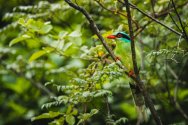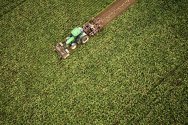
Dossier
Amazon
The weather in the Amazon is more often dry nowadays and when it is, the world's biggest rainforest produces vast quantities of CO2. This may be the forest's death warrant, with serious consequences for climate. Wageningen researchers see both signs of stress and a surprising degree of resilience.
A lot of water combined with heat and sunlight provide ideal conditions for luxuriant plant growth. This becomes apparent when rain suddenly becomes scarce, as it did in 2005, 2010 and 2015. The vegetation grew at a slower pace and there were more forest fires.
The forest remains a tropical rainforest
Drought causes problems for trees and other plants which are used to a humid environment. The crowns of trees thin out and some trees die off completely. The response of forests to more frequent droughts is surprising: the forest may change in the composition of species present but it remains tropical rainforest, with more or less the same amount of biomass and of sequestrated CO2.
Research chair group Meteorology and Air Quality
Ingrid van der Laan-Luijkx, assistant professor at the Meteorology and Air Quality chair group, can see such effects from Wageningen by studying the air quality above the Amazon. Van der Laan's lab is working with Brazilian researchers who take regular air samples from a small plane at different altitudes above the Amazon.
Want to know more?
- What will the Amazon do? Wageningen World, 2016-4
- Regional atmospheric CO2 inversion reveals seasonal and geographic differences in Amazon net biome exchange, Global Change Biology, 28 April 2016
- Collecting air above the Amazon. Resource, 12 Feb 2015
Publications about the Amazon
-
Simple ecological indicators benchmark regeneration success of Amazonian forests
Communications Earth and Environment (2024), Volume: 5, Issue: 1 - ISSN 2662-4435 -
Winner–loser plant trait replacements in human-modified tropical forests
Nature Ecology and Evolution (2024), Volume: 9, Issue: 2 - ISSN 2397-334X - p. 282-295. -
Tracing the History of the Taruma People through Plants, Their Names, and Uses
Journal of Language Contact (2024), Volume: 17, Issue: 3 - ISSN 1877-4091 - p. 498-532. -
Understanding the diversity of private conservation in the Peruvian Amazon
Conservation Science and Practice (2024), Volume: 6, Issue: 10 - ISSN 2578-4854 -
The biogeography of the Amazonian tree flora
Communications Biology (2024), Volume: 7 - ISSN 2399-3642 -
The Mystery of Black Rice: Food, Medicinal, and Spiritual Uses of Oryza glaberrima by Maroon Communities in Suriname and French Guiana
Human Ecology (2024) - ISSN 0300-7839 -
State of Wildfires 2023-2024
Earth System Science Data (2024), Volume: 16, Issue: 8 - ISSN 1866-3508 - p. 3601-3685. -
A new data-driven map predicts substantial undocumented peatland areas in Amazonia
Environmental Research Letters (2024), Volume: 19, Issue: 9 - ISSN 1748-9326 -
How rainfall events modify trace gas mixing ratios in central Amazonia
Atmospheric Chemistry and Physics (2024), Volume: 24, Issue: 15 - ISSN 1680-7316 - p. 8893-8910. -
CloudRoots-Amazon22: Integrating clouds with photosynthesis by crossing scales
Bulletin of the American Meteorological Society (2024), Volume: 105, Issue: 7 - ISSN 0003-0007 - p. E1275-E1302.









